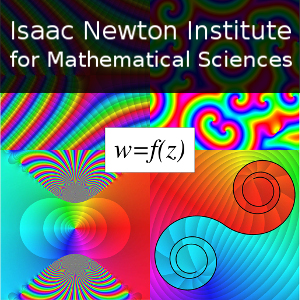Reduced order models for spectral domain inversion: embedding into the continuous problem and generation of internal data.*
34 mins 25 secs,
87.25 MB,
WebM
640x360,
30.0 fps,
44100 Hz,
346.12 kbits/sec
Share this media item:
Embed this media item:
Embed this media item:
About this item

| Description: |
Moskow, S
Thursday 12th December 2019 - 16:00 to 16:30 |
|---|
| Created: | 2019-12-16 12:42 |
|---|---|
| Collection: | Complex analysis: techniques, applications and computations |
| Publisher: | Isaac Newton Institute |
| Copyright: | Moskow, S |
| Language: | eng (English) |
| Distribution: |
World
|
| Explicit content: | No |
| Aspect Ratio: | 16:9 |
| Screencast: | No |
| Bumper: | UCS Default |
| Trailer: | UCS Default |
| Abstract: | We generate data-driven reduced order models (ROMs) for inversion of the one and two dimensional Schr\"odinger equation in the spectral domain given boundary data at a few frequencies. The ROM is the Galerkin projection of the Schr\"odinger operator onto the space spanned by solutions at these sample frequencies, and corresponds to a rational interpolant of the Neumann to Dirichlet map. The ROM matrix is in general full, and not good for extracting the potential. However, using an orthogonal change of basis via Lanczos iteration, we can transform the ROM to a block triadiagonal form from which it is easier to extract the unknown coefficient. In one dimension, the tridiagonal matrix corresponds to a three-point staggered finite-difference system for the Schr\"odinger operator discretized on a so-called spectrally matched grid which is almost independent of the medium. In higher dimensions, the orthogonalized basis functions play the role of the grid steps. The orthogonalized basis functions are localized and also depend only very weakly on the medium, and thus by embedding into the continuous problem, the reduced order model yields highly accurate internal solutions. That is to say, we can obtain, just from boundary data, very good approximations of the solution of the Schr\"odinger equation in the whole domain for a spectral interval that includes the sample frequencies. We present inversion experiments based on the internal solutions in one and two dimensions. * joint with L. Borcea, V. Druskin, A. Mamonov, M. Zaslavsky |
|---|---|
Available Formats
| Format | Quality | Bitrate | Size | |||
|---|---|---|---|---|---|---|
| MPEG-4 Video | 640x360 | 1.93 Mbits/sec | 499.49 MB | View | Download | |
| WebM * | 640x360 | 346.12 kbits/sec | 87.25 MB | View | Download | |
| iPod Video | 480x270 | 522.13 kbits/sec | 131.62 MB | View | Download | |
| MP3 | 44100 Hz | 249.79 kbits/sec | 63.00 MB | Listen | Download | |
| Auto | (Allows browser to choose a format it supports) | |||||

